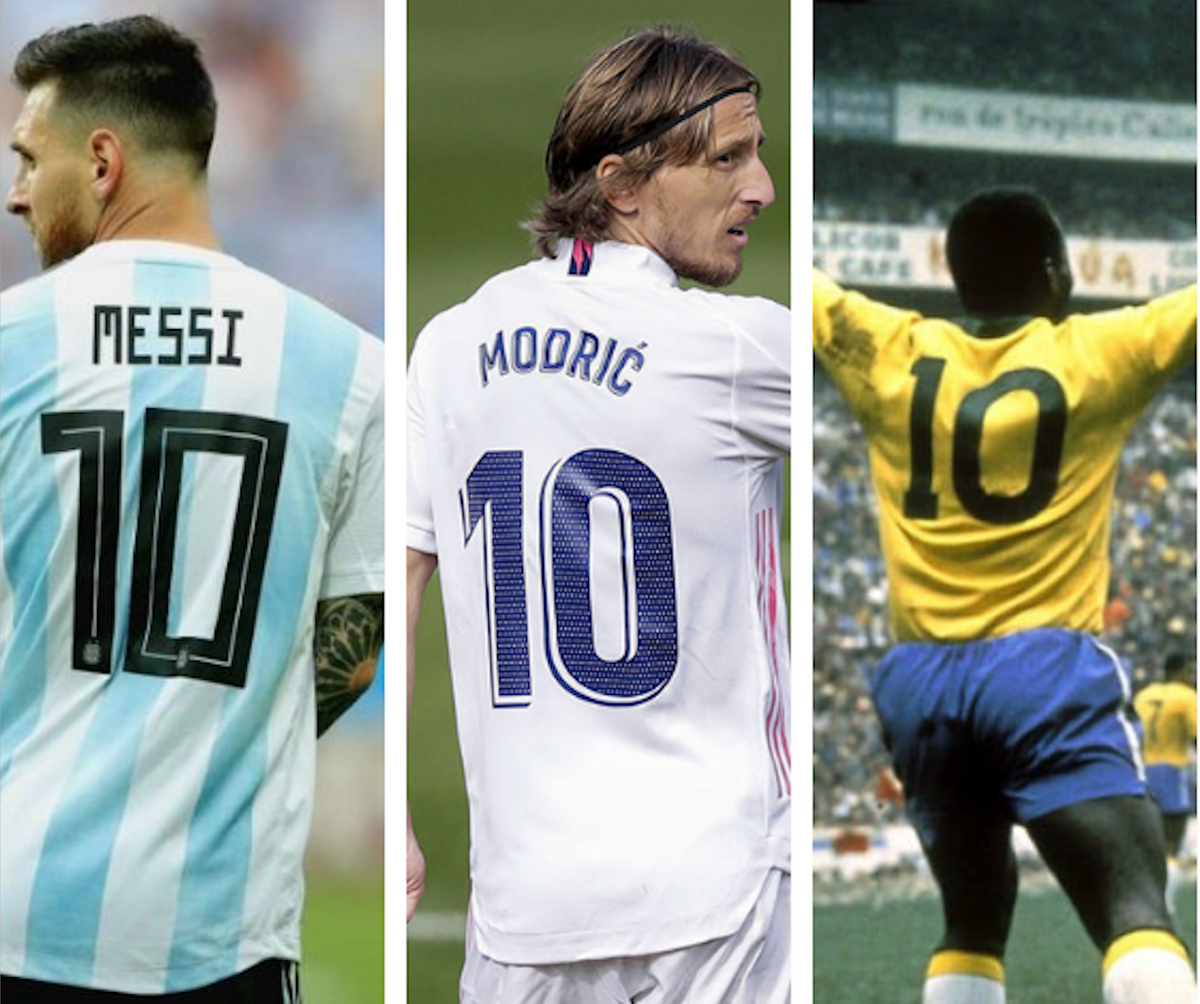The Evolution of the Iconic Number 10 in Soccer
In soccer, the list of remarkable number 10s is as endless as the love for the beautiful game itself. These players have graced the pitch with their extraordinary skills, capturing the hearts of fans and etching their names into the annals of history.

The number 10 jersey has become a symbol of skill, leadership, and genius in soccer history. Over seven decades, from 1950 to 2023, the evolution of the number 10 role has mirrored the broader developments and shifts within the sport itself. This article unravels the nuanced journey of the number 10, paying homage to the legends who donned the jersey and transformed how soccer - or football - is played and perceived.
Georghe Haghi.
Michael Laudrup.
Willem van Hanegem.
Henrik Larsson.
Rivaldo.
Eden Hazard.
Günther Netzer.
Wayne Rooney.
Francesco Totti.
Mesut Özil.
Ronaldinho.
Eusebio.
Lothar Matthäus.
Zlatan Ibrahimovic
The list of remarkable 10s is endless.
The role of the number 10 is constantly evolving, particularly in the last ten years. Guys wearing the 10-jersey traditionally played essentially as the shadow striker. A "10" was supposed to be the ideal game orchestrator. Luca Modric is a prime example. The Croatian maestro dictated the proceedings on the field for Real Madrid and his national team, controlling the tempo of play with his ability to slow down or accelerate the game. However, Modric is no longer guaranteed a spot in the starting lineup, primarily because modern soccer has become more dynamic and relies heavily on playmaking from deeper positions.
The central defenders, in conjunction with the defensive midfielder, have formed a triangle that devises and initiates attacking patterns. The number 6, once considered a mere midfield workhorse, has become the linchpin around which the game revolves.
Nevertheless, the number 6 can still hold its own compared to the number 10. The tradition of assigning the jersey number 10 to the 'best' or 'most skilled' player in a soccer team has historical and cultural roots. Here are some reasons why this is the case.
10 = Symbolic Significance
The number 10 is symbolic in many cultures, often associated with completeness, unity, and excellence. In numerology, the number 10 is usually explained as the beginning of a new cycle or a transition to a new level of experience and growth. The number 1 in 10 emphasizes leadership, assertiveness, and independence. It points to the ability to stand alone and lead. Perhaps that's why goalkeepers also wear the number 1 on their jerseys.
10 = Historical
In the history of soccer, many of the greatest players, such as Pelé, Diego Maradona, and Lionel Messi, have worn the number 10 jersey. Their extraordinary performances have contributed to the mystique and prestige of the number.
10 = Attacking
Traditionally, the number 10 position is allocated to the attacking midfielder or the 'playmaker' in the team, who is often responsible for setting up attacks, scoring goals, and providing assists. This position requires a high level of technical skill, insight, and creativity, which often makes it occupied by one of the most talented players in the team.
10 = Leadership and Responsibility
The player wearing the number 10 jersey is often viewed as a leader who can control and influence the game with their skills and decisions. This requires technical skills, mental strength, and leadership, which often go hand in hand with being the "best" player.
10 = Media and Fan Culture
The media and fan culture surrounding soccer have also played a role in building up the status of the number 10. Stories, legends, and mythologies built up around players wearing this number have contributed to its special status.
Defining the number 10 isn't straightforward. Positionally, they navigate the space between the opposing team's penalty area and the midfield circle, demonstrating proficient dribbling skills and exceptional passing techniques. Mentally, they embody soccer intelligence, crafting strategies to pierce through the opposition's defense with remarkable vision and technical prowess. They bear a significant responsibility and are often the nucleus around which the team is built, showcasing an extraordinary blend of talent and leadership.
The 1950s: The Birth of a Legacy
In the 1950s, soccer rapidly gained traction as a global sport, a vibrant congregation of enthusiasts, narratives, and moments that would later become sacred. The number 10 jersey had not yet solidified its iconic status, but the stage was set for the emergence of players who would make the number synonymous with brilliance and mastery.
During this period, we witnessed the rise of legendary players like Alfredo Di Stefano and Ferenc Puskás. Though Di Stefano probably was the better player, he doesn't play a role in this article simply because he wore number 9.
Puskás had an exceptional ability to score goals from every half-chance. The striker's short international career was nothing less than spectacular, scoring 84 goals in just 85 matches for Hungary. He has broken several records and has one of the best goal-to-game ratios in international soccer history.
Puskás has won almost everything in his club career. However, he could not achieve all the glory he deserved on the international stage due to the prevailing geopolitics of the Hungarian region. He was on tour across Europe, playing in the European Cup with his club Honved in 1956 when tragedy struck back in his homeland. The Hungarian Revolution destabilized the country, and the USSR sent troops to quell the uprising. His international footballing career ended as he refused to return to his homeland after Soviet troops entered the country.
Despite his exile and a prolonged spell without a club, Puskás revived his career with Real Madrid. UEFA banned him for two years for not returning to Budapest. He was without a club or country to play for in the prime years of his career. However, Puskás joined Real Madrid as a 31-year-old player who was reported to be overweight after a two-year ban. But he surprised everyone by scoring 242 goals in 262 games for Real Madrid, which is simply a dream goal ratio for any player.
Puskás retired at 39 after an extraordinary career at Real Madrid, winning 14 trophies in 9 seasons.
The 1960s: The Era of Pele
The 1960s marked the beginning of Pele's reign, arguably the first player to epitomize the quintessential number 10 archetype. With his mesmerizing skills, flawless ball control, and prolific goal-scoring record, Pele offered a tantalizing glimpse of the power and influence a number 10 could wield on the field. He introduced artistry to the game, transforming soccer into a canvas on which he painted unparalleled beauty and genius moments.
However, at Manchester United, there was another number 10 we must not forget: Dennis Law. Fondly referred to as 'The Lawman' by the Old Trafford faithful, Law was among the finest players to grace the Theatre of Dreams. Sir Matt Busby, who had coached legendary players, once called Law the best player he ever managed, a significant compliment coming from the legendary Scotsman.
In 1964, Law claimed the prestigious Ballon d'Or while wearing the number 10 jersey. He was integral to Manchester United's Holy Trinity of attackers alongside George Best and Sir Bobby Charlton.
Pele's brilliance
But then again, The Lawman was nowhere as towering a figure as Pele. Born Edson Arantes do Nascimento on October 23, 1940, in Três Corações, Brazil, Pele remains a living legend and an icon whose influence transcends boundaries. His journey to soccer superstardom commenced on the streets of Bauru, where he honed his skills with a makeshift ball, displaying a natural talent that would eventually captivate the world. His ascent to stardom was rapid, and at the tender age of 16, he made his debut for Santos FC, a club that would forever be associated with his name.
Pele's extraordinary versatility on the pitch set him apart. As a forward with the uncanny ability to score goals with both feet and his head, he effortlessly glided past defenders, leaving them bewildered and fans in awe. His vision and passing ability were equally remarkable, making him a prolific scorer and a brilliant playmaker.
Pele's crowning moment on the international stage occurred during the 1958 World Cup when, at just 17, he played a pivotal role in leading Brazil to its first-ever World Cup victory. He scored a memorable hat-trick in the semifinals against France and two crucial goals in the final against Sweden, leaving the world without doubt about his prodigious talent.
Throughout his illustrious career, Pele scored an astonishing 1,279 goals in 1,363 appearances, a feat that remains unmatched today. Most of his club career was spent with Santos FC, where he amassed numerous domestic and international titles, including the Copa Libertadores. In 1975, he made a high-profile move to the New York Cosmos, introducing the North American soccer scene to his unique brand of magic.
Pele's legacy extends far beyond the soccer pitch. He became a global ambassador for the sport, using his fame to promote peace, unity, and sportsmanship. His influence transcended national boundaries, and he remains a beloved figure worldwide. Even in retirement, Pele's star continues to shine brightly. He is frequently cited as one of the greatest athletes of all time, a symbol of Brazil's soccer prowess, and an enduring source of inspiration for aspiring players worldwide.
The 1970s and 1980s: The Golden Age of '10'
In the following decades, we have witnessed the emergence of several prodigious talents who embraced and enriched the legacy of the number 10 jersey. The 1970s and 1980s are often celebrated as a golden era, graced by players like Johan Cruijff, Michel Platini, and Diego Maradona.
Perhaps Cruijff was the best of all, certainly the most innovative as a playmaker, an influencer, and later as a coach for AFC Ajax and FC Barcelona. However, he never wore the number 10 on his back; his lucky number was 14.
Honestly, I don't believe Michel Platini was good enough to be included among the world's best number tens. Sorry, Michel, but Maradona was in a class of his own. Diego might even be the best 10 I've ever seen. He redefined the number. Like Cruijff, he could do it all. He was a playmaker with god-given talent, capable of single-handedly dictating the flow and outcome of a match. His dazzling dribbles, precise passes, and extraordinary goal-scoring ability captivated audiences worldwide.
I first met Maradona in person after the World Cup match between Argentina and Brazil in Turin, Italy. He showed me his bloodied ankle, battered by Brazilian defenders. Despite the excruciating pain, Maradona had connected with his striker, Caniggia, who scored the only goal of the match, sending Argentina to the quarter-finals.
Maradona's touch and control were extraordinary. Whether receiving a pass, taking on opponents, or shooting, he could manipulate the ball effortlessly, often making it seem like an extension of his body. His close ball control, quick footwork, and low center of gravity allowed him to navigate through tight spaces and take on multiple defenders easily. He could change direction rapidly and maintain possession of the ball in seemingly impossible situations. Maradona possessed exceptional creativity and vision on the field, executing passes that others couldn't imagine. Despite his relatively small stature, he was swift and agile. He accelerated, changed direction swiftly, and left defenders trailing behind him. He could maintain equilibrium under pressure, allowing him to stay on his feet and avoid fouls.
Maradona had a natural goal-scoring instinct. He could finish with both feet and was skilled in heading the ball. His ability to score from various positions on the field made him a constant threat to opposing defenses. He thrived under pressure and often elevated his performance in critical moments, such as during World Cup matches.
Maradona's passion for the game and charismatic personality endeared him to fans worldwide. He played with heart and emotion, making him a cultural icon. He often served as a leader on the field, motivating his teammates and inspiring them to perform at their best. His mere presence had a significant impact on his teams.
Maradona is remembered for some of the most iconic moments in football history, including the "Hand of God" goal and the "Goal of the Century" in the 1986 FIFA World Cup. These moments solidified his legacy as one of the most excellent number 10s ever.
El Pibe
As an outsider, I would also like to advocate for Carlos Valderrama as one of soccer's best 10's. Valderrama, often affectionately referred to as "El Pibe" (The Kid), is personally seen as one of the most iconic playmakers in the history of soccer. His distinctive appearance, with his blonde, curly hair and bushy mustache, was matched only by his unique playing style and unrivaled vision on the field. He was a midfield maestro, capable of dictating the tempo of a match with his precise passing, ball control, and vision. His ability to pick out teammates accurately made him a dream for strikers, as he consistently provided goal-scoring opportunities on a silver platter. Valderrama's passing range and creativity were a sight to behold, and he had an innate understanding of the game's nuances.
He showcased that intelligence and creativity could trump physicality on the field, leaving an indelible mark on the sport. His distinctive presence and unforgettable performances will forever make him an enduring symbol of Colombian soccer.
The 1990s: A Time of Transition
As soccer ventured into the 90s, the landscape of the sport began to change. The role of the number 10 began to evolve to accommodate the increasing pace and physicality of the game. This era saw the rise of players like Roberto Baggio and Zinedine Zidane, who combined grace and skill with a newfound intensity and athleticism.
Baggio, with his poetic style of play, and Zidane, with his elegance and vision, continued to glorify the number 10 jersey, adapting and refining the role to meet the demands of modern soccer.
But perhaps the best representative was Dennis Bergkamp. He never boasted about his skills, but for his teammates at Ajax, Internazionale, and Arsenal, it was almost a given that Bergkamp was the maestro. Not only because he possessed an incredible technique and excellent vision but also because he always wanted to win and exuded that invincibility.
Bergkamp's first touch and ball control were unparalleled. He possessed an uncanny ability to manipulate the ball with grace and precision. His technique was often described as otherworldly, and he could effortlessly bring down long passes or deliver exquisite assists. His skills left defenders bewildered and spectators in awe.
Bergkamp was a versatile forward, equally comfortable playing as a striker or in a more withdrawn role as an attacking midfielder. This adaptability allowed him to influence the game from various positions on the pitch. His vision and creativity made him a playmaker, while his clinical finishing made him a goal-scoring threat. His time at Arsenal in the late 1990s and early 2000s marked a golden era for the club. He played a pivotal role in transforming Arsenal into one of England's top clubs and was instrumental in their domestic and international successes. His partnership with Thierry Henry and other teammates produced some of the most memorable moments in the club's history.
Bergkamp is renowned for scoring some of the most iconic goals in soccer history. His goal against Newcastle United in 2002, where he controlled a long pass with a sublime first touch before finishing with precision, is often considered one of the most significant goals ever scored in the English Premier League.
Beyond his playing career, Bergkamp's influence extended to coaching and mentoring. He worked as an assistant coach at Ajax, contributing to the development of young talent, and his soccer philosophy continues to shape the game.
The 2000s: The Kingdom of Messi
We have reached a period that is still fresh in many people's memories. To identify the best tens (positionwise), we must look to Spain and Italy. In Spain, Xavi Hernandez caught the eye, while in Italy, Andrea Pirlo made a name for himself.
Xavi Hernandez (jersey number 6) emerged as the linchpin of Barcelona and Spain's golden era, orchestrating plays from deeper positions, a departure from the conventional role of a number 10 in the final third. His exceptional ball control and unique ability to dictate the game's tempo from these deeper areas left an indelible mark on both club and international stages. Xavi holds an unparalleled record of assists in two Champions League and European Championship finals.
In Luis Aragones' dynamic 4-1-3-2 setup, players like Iniesta and Silva adeptly occupied wide half spaces, interchanging roles seamlessly and bewildering opponents with their unpredictable movements. These 'shadow 10s,' as they became known, added a new dimension to the game, making it considerably more challenging for opponents to mark them. Tika-Taka, initiated by Johan Cruijff and developed by his disciples Frank Rijkaard and Pep Guardiola, stunned the world. Or should we say shaped soccer as we know it today?
Andrea Pirlo: The Renaissance in the Italian Theater
Meanwhile, in the vibrant landscape of Italian soccer, Andrea Pirlo (jersey number 21) was crafting a narrative parallel to Xavi's, redefining the role of the central playmaker. Initially a number 10 in his early years, Pirlo transitioned to a more profound role after his move to AC Milan following a lackluster stint at Inter Milan. This transformation took place at Brescia under the guidance of Carlo Mazzone, who envisioned Pirlo as a defensive anchor with a playmaker's vision, making more efficient use of the available space in Brescia's half.
This reshaped role allowed Pirlo to blossom as a central figure in Ancelotti's dominant Milan squad, leading them to numerous triumphs and playing a pivotal role in Italy's successful campaigns in World Cups and European Championships. He also spearheaded Juventus' resurgence in later years.
In essence, the contributions of Xavi and Pirlo illustrated that the role of the traditional number 10 evolves. Teams could still dictate the game's rhythm and consistently create opportunities from central regions without relying on a quintessential number 10. This shift allowed coaches to deploy an additional player in offensive roles without diminishing the strategic depth and vision traditionally provided by the number 10 role.
Bielsa's Vision: Shaping the Future of the Number 10
To understand the trajectory of the number 10 role in modern football, one must explore the strategies employed by visionary Marcelo Bielsa. Always ahead in the tactical game, Bielsa envisions the number 10 as a versatile 'box-to-box' player, proficient in initiating rapid creative moves without neglecting defensive responsibilities. The number 10 is expected to possess the stamina to press opposition CDMs while also displaying the agility to roam across the pitch, identify strategic spaces, and occasionally swap roles with wingers.
This new breed of number 10s is exemplified by players like Bruno Fernandes, who, while deviating from traditional number 10 characteristics, represent a modern, efficient, and defensively resilient version of the role. Fernandes embodies the shift towards a more outcome-focused approach, seamlessly adapting to various positions without confining himself to the classical central playmaking role.
And right through it all, there's Lionel Messi, who takes control of the game and defies conventions. He fills the number 10 role in his way. With leadership, charisma, ingenuity, and velvet-like technique, only the greats of the earth can demonstrate. His understanding of 'spaces' is unrivaled, and his shooting technique is unparalleled.
Throughout the 2000s and 2010s, the Argentine dazzled the world with his extraordinary skill set. His close ball control, dribbling ability, and goal-scoring prowess still are magical. Messi's time wearing Barcelona's number 10 jersey marked an era of great success and individual accolades, establishing the number 10 as a symbol of excellence and virtuosity in the sport.
Fans love him.
Journalists adore him.
The media embraces him.
Yesterday, he was named Soccer Player of the Year for the eighth time.
Eight Ballon d'Ors (golden balls)!
Sometimes, words fall short.
Sometimes, only an admiring silence suffices.




